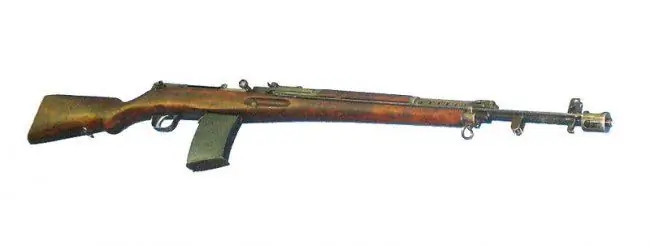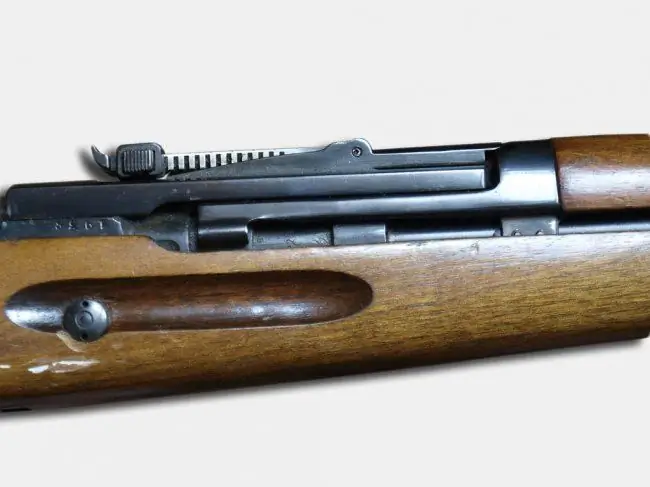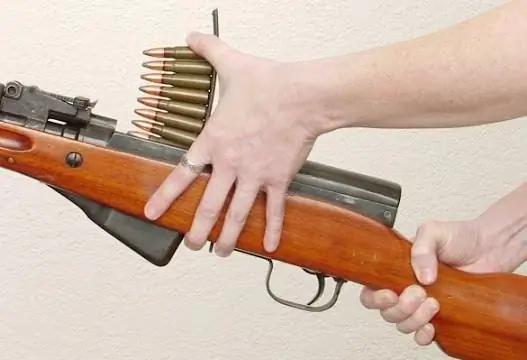- Author Matthew Elmers [email protected].
- Public 2023-12-16 21:49.
- Last modified 2025-01-24 09:17.
Automatic rifle Simonov AVS-36 (USSR)

The Red Army began the first tests of self-loading rifles back in 1926, but until the mid-thirties, none of the tested samples met the army's requirements. Sergei Simonov began developing a self-loading rifle in the early 1930s and exhibited his developments at competitions in 1931 and 1935, but only in 1936 a rifle of his design was adopted by the Red Army under the designation "7.62-mm Simonov automatic rifle, model 1936", or ABC-36. Experimental production of the AVS-36 rifle began in 1935, mass production in 1936 - 1937 and continued until 1940, when the AVS-36 was replaced in service with the Tokarev SVT-40 self-loading rifle. In total, according to various sources, from 35,000 to 65,000 AVS-36 rifles were produced. These rifles were used in the battles on Khalkhin Gol in 1939, in the winter war with Finland in 1940, as well as in the initial period of the Great Patriotic War. Interestingly, the Finns, who captured both Tokarev's and Simonov's rifles as trophies in 1940, preferred to use the SVT-38 and SVT-40 rifles, since the Simonov rifle was much more complex in design and more capricious. However, that is why Tokarev's rifles replaced the AVS-36 in service with the Red Army.

The AVS-36 rifle is an automatic weapon that uses a propellant gas vent and allows single and automatic fire. The fire mode translator is made on the receiver on the right. The main mode of fire was single shots, automatic fire was supposed to be used only when repelling sudden enemy attacks, while with the consumption of cartridges in bursts of no more than 4-5 magazines. The short-stroke gas valve is located above the barrel (for the first time in the world). The barrel is locked using a vertical block that moves in the grooves of the receiver. When the block was moved upward under the action of a special spring, it entered the grooves of the shutter, locking it. Unlocking occurred when a special clutch connected to the gas piston squeezed the locking block down from the bolt slots. Since the locking block was located between the breech of the barrel and the magazine, the trajectory of feeding the cartridges into the chamber was rather long and steep, which served as a source of delays in firing. In addition, because of this, the receiver had a complex design and great length. The device of the bolt group was also very complicated, since there was a drummer with a mainspring and a special anti-rebound mechanism inside the bolt. The rifle was powered from detachable magazines with a capacity of 15 rounds. Stores could be equipped either separately from the rifle, or directly on it, with the bolt open. To equip the store, standard 5-cartridge clips from the Mosin rifle were used (3 clips per magazine). The rifle barrel had a large muzzle brake and a bayonet-knife mount, while the bayonet could adjoin not only horizontally, but also vertically, with the blade down. In this position, the bayonet was used as a one-legged bipod for shooting from a stop. In the stowed position, the bayonet was carried in a scabbard on the soldier's belt. The open sight was marked with a range of 100 to 1,500 meters in 100 meter increments. Some AVS-36 rifles were equipped with a telescopic sight on a bracket and were used as sniper rifles. Due to the fact that the spent cartridges are thrown out of the receiver up and forward, the telescopic sight bracket was attached to the receiver to the left of the weapon axis.

SKS - Simonov self-loading carbine mod. 1945 year

The experience gained during the first half of World War II showed the need to create weapons that are lighter and more maneuverable than the self-loading and magazine rifles that are in service, and at the same time have greater firepower and effective firing range than submachine guns. Such weapons first of all required the creation of cartridges that were intermediate in characteristics between pistol and rifle ones, and provide an effective range of about 600-800 meters (versus 200 meters for pistol cartridges and 2000 or more meters for rifle cartridges). Such cartridges were created both in Germany (cartridge 7.92mm Kurz) and in the USSR (cartridge 7.62x41mm, which later turned into 7.62x39mm). While in Germany they focused mainly on one, the most versatile type of weapon for an intermediate cartridge - an automatic carbine (MaschinenKarabiner), later renamed an assault rifle (SturmGewehr), in the USSR, the development of a whole family of weapons for a new cartridge was started. This family included a magazine carbine, a self-loading carbine, an assault rifle (the same assault rifle) and a light machine gun. The first samples of weapons of the new family appeared by the end of the Great Patriotic War, and their massive entry into service began only at the end of the 1940s. The magazine carbine, as an obviously outdated concept, remained only in the form of prototypes. The role of the assault rifle was taken over by the Kalashnikov assault rifle. Light machine gun - RPD. And the SKS was adopted as a carbine.
The first samples of a self-loading carbine for a new cartridge were created by the designer Simonov by the end of 1944. A small experimental batch of carbines was tested at the front, however, the development of both the carbine and the new cartridge continued until 1949, when the "7.62-mm self-loading Simonov carbine - SKS mod. 1945" was adopted by the Soviet army. During the first post-war decades, the SKS was in service with the SA on a par with the AK and AKM, but with the proliferation of machine guns, the gradual ousting of the SKS from the troops began, although a certain number of them were in service until the 1980s and even the 1990s in such branches of the military as communications and air defense, where small arms are not the main one. Up to the present time, SCS are used as a ceremonial weapon due to aesthetics that is much greater than that of modern assault rifles.

As in the case with other samples of post-war weapons, SCS became widespread in the countries of the socialist camp and others who were friends with the USSR. SKS under license was produced in China (carbine Type 56), in the GDR (Karabiner-S), Albania, Yugoslavia (Type 59 and Type 59/66) and a number of other countries. With the withdrawal from service, a significant number of SCS ended up on the civilian arms markets both in their original and in more or less "civilized" form. Moreover, as a rule, "civilization" was reduced to the removal of the bayonet. The low price of both the carbines themselves and the cartridges for them, combined with high operational and combat characteristics, ensured SCS great popularity among civilians in various countries - from Russia to the United States. It should be noted that the Americans are very fond of Simonov carbines, since with the reliability and combat data comparable to other samples (AR-15, Ruger Mini-30), the SKS has a much lower price.
SKS is a self-loading shortened rifle (carbine), built on the basis of automatic equipment with a gas engine. The gas outlet chamber and the gas piston are located above the barrel. The gas piston is not rigidly connected to the bolt carrier and has its own return spring. Locking is carried out by tilting the bolt downward, behind the combat stop in the bottom of the receiver. The bolt is installed in a massive bolt carrier, on the right side of which the handle for loading is rigidly fixed. USM trigger, the fuse is located in the trigger guard.

A distinctive feature of the SKS is an integral middle magazine, equipped with separate cartridges when the shutter is open or with the help of special clips for 10 rounds. The clip is installed in the guides made in the front end of the bolt carrier, after which the cartridges are pressed into the store, as shown in the photo. In connection with such a loading scheme, a bolt delay is provided in the design of the carbine, which turns on when all the cartridges in the store are used up and stops the bolt group in the open position. For quick and safe unloading, the lower magazine cover can be folded down and forward, its latch is located between the magazine and the trigger guard.
Sights of the SCS are made in the form of a front sight on the base in a protective ring and an open rear sight with range adjustment. The stock is solid, wooden, with a semi-pistol butt neck and a metal butt pad. SKS is equipped with an integral bladed bayonet, in the stowed position, retracted downward under the barrel. Chinese Type 56 carbines have a longer needle bayonet with a similar mount.
Unlike the original SKS, the Yugoslav-made type 59/66 carbines have a combined muzzle device designed to launch rifle grenades. For this, a folding grenade sight behind the front sight and a gas cutoff in the gas chamber, which is activated when firing a grenade and closes the gas outlet, is intended.
In general, as an army weapon, SKS is largely outdated, although it has an advantage over Kalashnikov assault rifles of 7.62mm caliber in the aiming range due to the longer barrel and sighting line. As a civilian weapon for hunting small and medium game (with the right choice of cartridges), the SCS remains at the modern level. The presence of a wide range of civilian accessories (boxes of various configurations, light bipods, mounts for optics, etc.) only expands the scope of this undoubtedly worthy and well-deserved example of Soviet weapons thought.
From the author: there is an opinion that SKS should take a place not among self-loading rifles, but among machine guns and assault rifles, based on the fact that it uses an intermediate cartridge. Nevertheless, since SKS lacks such a species-forming feature of assault rifles as the ability to conduct automatic fire, I believe that its place is precisely among ordinary self-loading rifles.
M. Popenker






